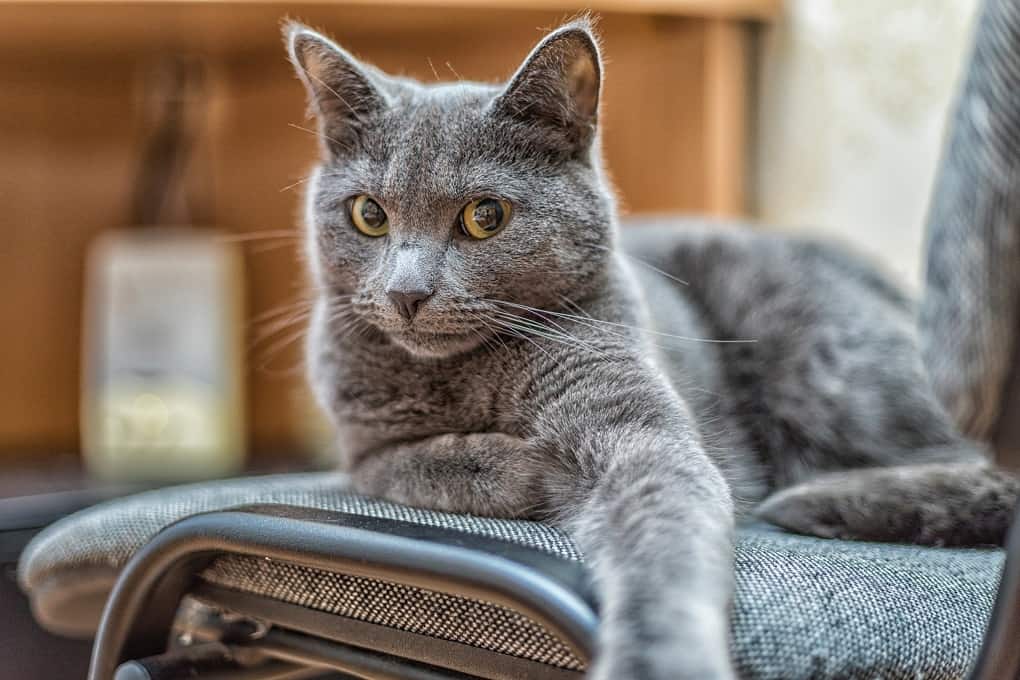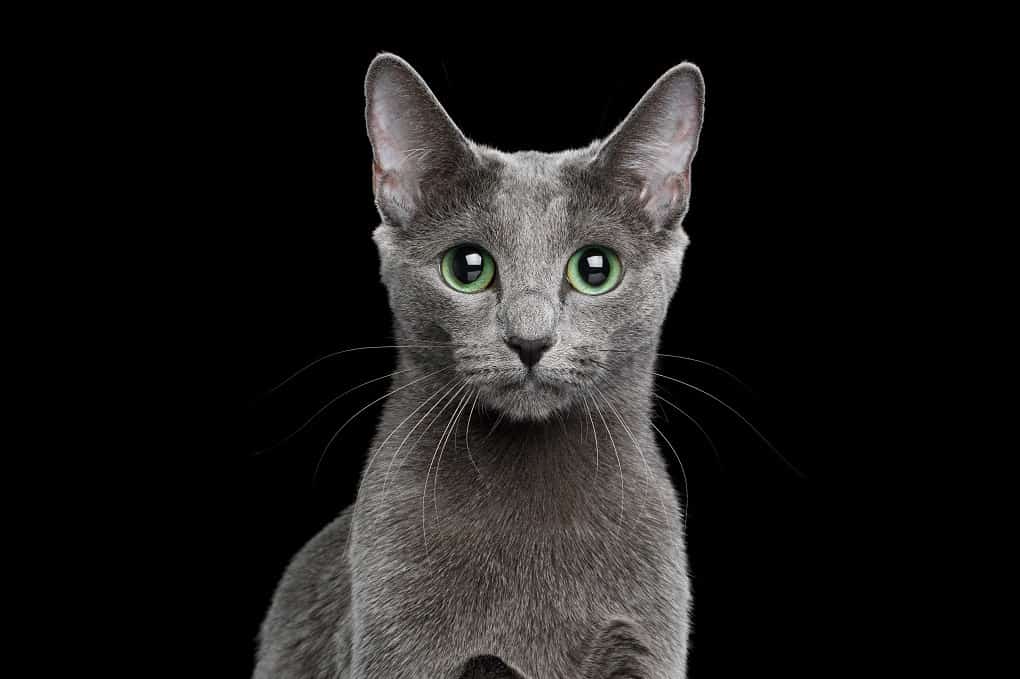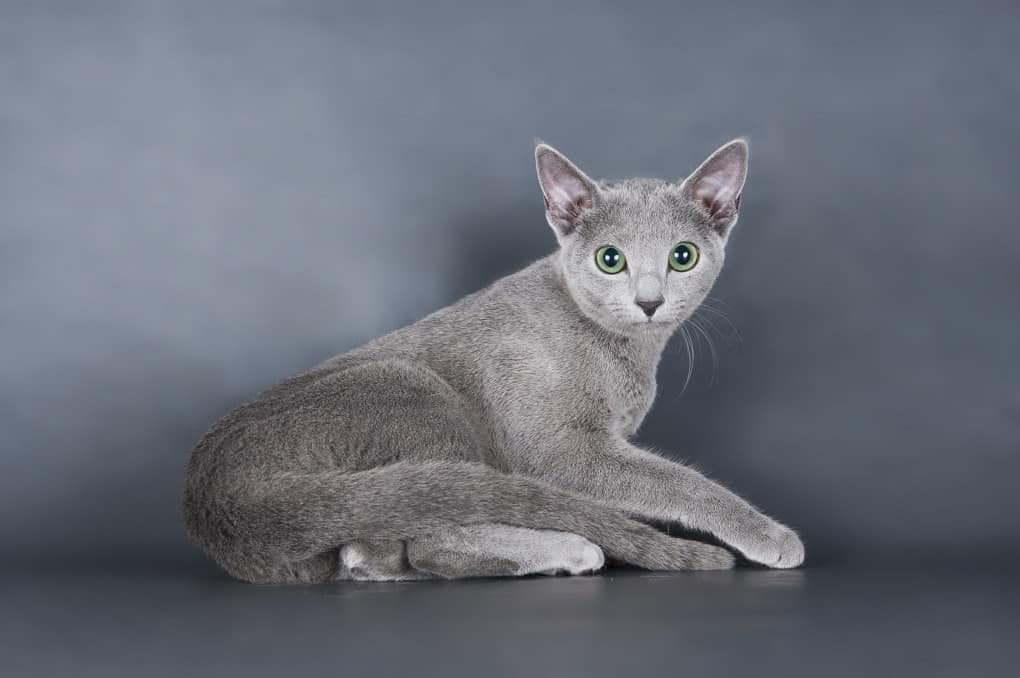Table of Contents

Cat breeds are about as unique as the people who care for them. Some cats are outgoing and happy to entertain groups of people, go on outdoor walks or even play fetch. Meanwhile, others prefer a quieter, calmer space where they can enjoy the love of their owners and explore on their own terms.
Russian Blues fall into the latter category. These intelligent cats tend to be rather independent. They enjoy playing, climbing and causing mischief without too much supervision. In addition, they are very gentle and quiet, enjoying some relaxation in their owner’s lap at the end of the day.
What’s the nature of the breed?
Russian Blue cats are quiet, calm and typically somewhat reserved. They are affectionate, but don’t want to be the center of attention for too many people. These cats prefer spending quiet moments with their owners, enjoying a gentle brushing or petting.
If you’re looking for a cat who is independent, but also enjoys your company from time to time, this breed is the way to go.
Origin and history of the breed
We have known cats as companions for quite a long time, and they have aided us in many ways. Initially, they were kept around for pest control, but were also revered by some. Since then, they have only managed to find their way deeper into the hearts of humankind.
Breeds like the Russian Blue have only helped cats to adapt to into the different kinds of homes humans offer, and they are a great example of a quiet, well-behaved and loving cat.
Learn some interesting facts about Russian Blue Cat in the short video below:
The Russian Blue is quite an old breed, gaining full attention in 1875. It’s considered a cat that is unique even when compared to other blue breeds, so much so, that the breed had its own class separate from all others.
Since the 1960s, this breed has been a favorite to love at home as well as in cat shows.
Physical standards of the breed

Health and possible diseases
For those who are looking for a breed that is typically quite healthy, Russian Blue cats are a great option. There are a few serious issues they are likely to develop based on genetics.
Typically, there aren’t a large number of complications you’ll need to combat in your Russian Blue. Like for most cats, it is a good idea to prevent obesity and help heavier cats to slim down in a healthy way.
Russian Blue cats aren’t likely to develop many illnesses based on genetics, but they can be a little more prone to cat bladder stones. Because of this, it’s a good idea to keep an eye on their litter box habits and make sure they get checked out if you notice a pink tinge to their urine, or that they have begun urinating outside the box.
Grooming
For the most part, Russian Blues only require pretty basic grooming care. Regular nail trims, toothbrushing and combing are great for their well-being. Typically, giving them a brush a couple times a week will work perfectly well, but you may need to brush them a little more in the shedding seasons.
Height and size
These aren’t huge cats, standing in at somewhere around 10 inches in height.
Russian Blue cats sit about in the middle when it comes to size and are perhaps slightly larger than some other breeds. However, they don’t tend to get near the size of something like a Siberian or Maine Coon.
Weight
As a medium-sized cat, the Russian Blue can weigh anywhere from 10 to 12 pounds. Keep in mind that each cat may be a little different, so you’ll just want to make sure that their weight is healthy for their body size.
Activeness
These cats have about an average level of activeness when compared to other breeds. They aren’t hyper, but they do like to play, explore and climb. Furthermore, this is a breed that enjoys calm affection and cuddling up when you’re feeling ill.
Hypoallergenic
While these cats aren’t hypoallergenic, they can be a bit easier on those who have allergies related to cat fur and dander. As long as they are brushed regularly and your home is kept free from too much cat hair, they shouldn’t be too troublesome for most.
Lifespan
Russian Blues are capable of living up to around 20 years in the best of conditions. Keep in mind that there are some things that can affect this lifespan, such as whether they live indoors or outdoors, their quality of food and receiving regular vet checkups.
Caring Difficulty
As long as their basic needs are met, these cats aren’t difficult to care for. Just make sure they get regular checkups, exercise and plenty of love.
Where to get a Russian Blue Cat
The first place to look for any breed of cat is a shelter. If you’re just looking for a family pet, you may be able to find mixed or even purebred Russian Blues in need of homes.
Otherwise, make sure any breeder you purchase from has a good reputation. The kittens should be raised in a clean setting and given a lot of socialization and care.
How much does a Russian Blue Cat cost?
Compared to other breeds, Russian Blue cats may not be as costly. Even thou it still belongs to the list of expensive cats, you can find breeders who offer them for under $600.
For those who are looking for a simple pet and don’t want to pay quite so much, a shelter is also a great place to look.
Choosing the right type of Russian Blue Cat
There aren’t too many choices based on coloring or pattern that you have to make with a Russian Blue. It’s typically going to be based on the personality of each kitten. Make sure that you get to know the cat you’re interested in adopting, and determine whether or not they will fit well into your home.
Responsibilities to consider in the care of a Russian Blue Cat
What do they require?
Russian Blue cats don’t require much more than other breeds out there. Plenty of food, water, love and exercise will keep them happy and healthy.
Do they need a certain level of care and attention?
These cats aren’t particularly needy. They enjoy affection, especially in the quiet moments. These are cats that will happily rest on your lap while you watch TV, but they aren’t going to want to greet your party guests.
Characteristics of Russian Blue Cats
Behavior
Russian Blues are reserved cats, who like gentle play and affection. They aren’t as outgoing as other breeds, and tend to like smaller families and older children who are careful with them. Consequently, these cats are great for those who want a cat that is independent, but affectionate.
Pattern
The Russian Blue is a cat with fewer pattern and color options than others. After all, they are called a Russian Blue for a reason! Typically, these cats are found in solid blue/gray coloring.
Affectionate
These are cats that are known for being more reserved, but they still enjoy affection. While they may not beg for it, a Russian Blue will happily lay in your lap while you relax.
Dog/child-friendly
Russian Blue cats are friendly, but they do tend to prefer a more mellow atmosphere. So dogs who are gentle with cats, or pay them no mind and older children who can give them gentle affection are the ideal for these felines.
Intelligence
While quiet, Russian Blues are intelligent and enjoy exploring. They may end up in places you had no idea they could fit into, so keep an eye out for a bit of mischief!
Energy
When you’re looking for a cat that has enough energy to play, but isn’t driving you crazy with their excess need for exercise, a Russian Blue is a good choice. These cats are happy to play, but won’t need a ton of extra exercise to keep their behavior in check.
Maintenance
Largely, maintenance for a Russian Blue is quite simple. You won’t need to bathe them too often, unless they get into a messy state for some reason. Aside from that, the basics are plenty for this easygoing cat.
Types of Russian Blue Cats

For the Russian Blue there are essentially two types – the longhair Nebelung and the shorthair Russian Blue. Aside from this, the only variants you’re likely to see are mixed breeds.
Both Russian Blues and Nebelung cats typically only come in a blue/gray coloring. It is a color bred into the breed, so it’s unlikely to find many variations.
While they may come in different hair lengths, Russian Blue cats are typically just a solid pattern. In some cases, you may be able to see some very light tabby-like stripes but that’s as far as the pattern differences tend to go.
Russian Blue compared to other Breeds
There are so many different breeds of cat out there, and their personalities can really range. Some cats are very shy while others essentially behave like dogs. It’s up to you to think about what kind of personality would best suit you.
Russian Blue cats are somewhere in the middle. They do enjoy affection, but they are likely to split when visitors show up. These cats are great for quiet homes without too many rambunctious children or pets.
Conclusion
If you’re looking for a quiet, loving companion then a Russian Blue is a great way to go. You’re sure to find that these cats are entertaining, intelligent and extremely lovable. They are fantastic for those who live on their own, or smaller families.
These cats are also quite easy to take care of, so you won’t have to worry about a high-maintenance pet. Just make sure they get the love and grooming they need, and these little guys are happy to explore and enjoy your presence without being too demanding.